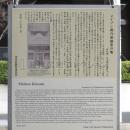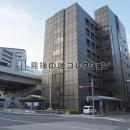メイゾン鴻乃巣 創業の地
めいぞんこうのすそうぎょうのち
東証等の金融の中心街から鎧橋を渡った東詰の北側の運河沿い、現在の日本橋小網町9−9附近に、メイゾン鴻乃巣はあった。
明治43年(1910)、横浜のホテルで西洋料理の修行をした奥田駒蔵が開いた東京で最初の西洋料理店。大正文士サロンという風情だったようだが、京橋に移ってからがどうやら賑やかだったらしい。大正14年(1925) 閉店。
東京都心は首都高速が建設されたり建物もほぼすべて建て替えられていて、当時の面影を探すのは難しい。
写真
碑文
メイゾン
鴻乃巣 創業の地所在地 日本橋小網町九−九
メイゾン鴻乃巣は、明治四十三年(一九一〇)夏、奥田
駒蔵 (一八八二〜一九二五、京都府出身)が日本橋小網町二丁目河岸地(鎧河岸)の鎧橋の袂において開業したバーを兼ねた西洋料理店でした。駒蔵は横浜のホテルでフランス料理の修業をし洋行の経験をもったといわれます。「西洋料理 鴻乃巣 KONOSU,FIRST CLASS BAR」の看板を掲げ、「メイゾン鴻乃巣」と名乗りました。
三間間口の一階は西洋風のバー、二階は畳敷きの部屋で窓からは日本橋川が望め、魚河岸などに行き交う小舟が浮かび、水鳥が飛び交い、江戸橋あたりには江戸の面影を残す列蔵が広がっていました。夜は黒く澱んだ川面に映る人家の明りは青白く、赤く、あるいは黄味がかった灯影を映していました。
その頃の若い詩人や作家や画家の間に、西洋の新しい風潮と江戸趣味が風靡していました。メイゾン鴻乃巣はそんな芸術家たちの心をとらえ、かれらの溜まり場となりました。
ここに集まった人々は、木下杢太郎 、高村光太郎 、吉井勇 、武者小路実篤 、志賀直哉 、里見弴 、郡虎彦 (萱野二十一 )、永井荷風 、三木露風 、小山内薫 、谷崎潤一郎 、市川猿之助 、上田敏 、石井柏亭 、山本鼎 など、『スバル』、『白樺』、『三田文学』、『新思潮』、そして「パンの会」などに拠った人々たちでした。
木下杢太郎は、メイゾン鴻乃巣の情景を詠んだ詩「該里酒 」を駒蔵に献呈しています。
メイゾン鴻乃巣は日本近代文学史の一ページを飾る場所でした。
メイゾン鴻乃巣は大正三年(一九一四)春頃までこの地で営業を続け、以後、日本橋区通一丁目食傷新道 (現、日本橋一丁目)、さらに京橋区南伝馬町三丁目(現、京橋二丁目)へ移転し、大正十四年十月に閉店しました。平成二十六年三月
中央区教育委員会
Maison Kōnosu
Location: 9-9 Nihonbashi Koamichō
Maison Kōnosu was a bar and Western-cuisine restaurant found in 1910 by Komazō Okuda (1882-1925, from Kyoto) in the Nihonbashi Koamichō 2-chome neighborhood near Yoroibashi, a bridge over the Yoroi River. Okuda had trained in French cooking at a hotel in Yokohama and had also traveled aboroad. Initially he hung up a sign as "Kōnosu Western Cuisine" in Japanese followed by "Konosu First Class Bar" in English. Later he changed to "Maison Kōnosu"
The building of 5.5m frontage had a Western-style bar on the first floor and the second floor contained traditional tatami rooms with windows overlooking the Nihonbashi River and its Edobashi bridge. There was a fine view of boats passing the river, fish markets along the riverbanks,water birds flying to and fro, and rows of storehouses retaining the classic view of the old Edo period. At night, the darkened river surface shone in pale white, reddish and yellowish reflections from the flickering lamps of the surrounding homes.
The young writers and painters of Tokyo in the early 20th century, who were charmed with both the Western vogue and the traditional styles of Edo, found Mainson Kōnosu attractive, and it became a gathering place of the artist community.
Many of the patrons for the restaurant became renowned for their creative careers. They were Mokutarō Kinoshita, Kōtarō Takamura, Isamu Yoshii, Saneatsu Mushanokōji, Naoya Shiga, Ton Satomi, Torahiko Kōri (Nijūichi Kayano), Kafū Nagai, Rofū Miki, Kaoru Osanai, Junichirō Tanizaki, Ennosuke Ichikawa, Bin Ueda, Hakutei Ishii, and Kanae Yamamoto. These people were associated with such infiuential literery magazines such as "Subaru", "Shirakaba", "Mita Bungaku", "Shinshichō" and "Pen-no-Kai". A poem by Mokutarō Kinoshita had composed a poem immortalizing the scene of Mainson Kōnosu titled "Sheri-shu (Cherry Wine)" and dedicated to the owner and chef, Komazō Okuda.
Maison Kōnosu was the place that left one page in the history of the modern Japanese literature.
Maison Kōnosu served at this location until the spring of 1914, and subsequently relocated to Shokushō Shinmichi in what is now Nihonbashi 1-chome, and then moved to Minami Denmachō in what is now Koōbashi 2-chome, finally closed in October 1925.March 2014
Chuo City Board of Education

